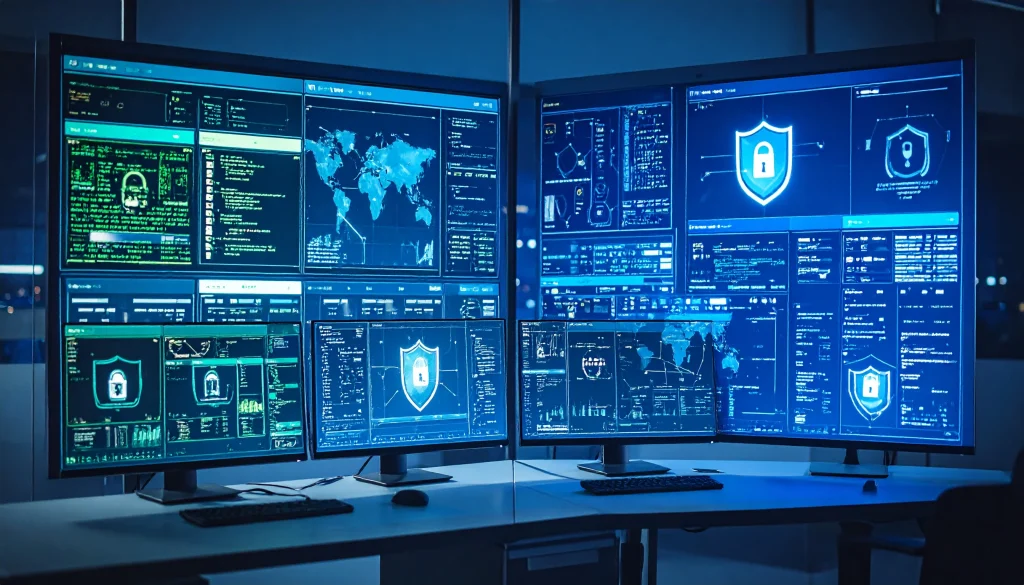When it comes to protecting digital infrastructure, Linux (Operating System) for Cybersecurity has become a foundational skill set for professionals in the field. From security analysts to penetration testers, the ability to navigate and leverage Linux environments can make the difference between responding to threats effectively and falling behind attackers.
Whether you’re monitoring logs, running vulnerability scans, or investigating breaches, this OS is often the environment of choice in modern security operations centers (SOCs).
Why Linux Is Popular in Security Environments

In cybersecurity, time is everything. This open-source OS for Cybersecurity offers the speed, flexibility, and reliability needed for critical security tasks. Many popular security tools—such as Wireshark, Nmap, and Metasploit—run natively on this OS, giving analysts a robust platform without additional compatibility issues.
Additionally, Linux’s open-source nature means you can customize your environment for specific security operations, automate workflows, and even inspect the code for potential vulnerabilities—something not possible with closed-source operating systems.
Linux vs Windows in Cybersecurity
While both Linux and Windows have roles in security operations, their design philosophies, flexibility, and tool ecosystems make them serve different purposes. In the context of this open-source OS for Cybersecurity, this OS is often the default choice for professionals who need transparency, customization, and reliability.
- Stability and Uptime: This OS servers often run for years without requiring a reboot, ensuring uninterrupted security monitoring.
- Security by Design: Linux’s permission model and smaller attack surface make it less prone to certain malware types.
- Tool Availability: Many penetration testing and forensic analysis tools are designed for this OS first, with Windows ports often arriving later or with reduced features.
- Customizability: This OS allows security professionals to tailor the OS for very specific tasks, improving operational efficiency.
Quick Comparison Table
| Feature / Consideration | Linux | Windows |
| Source Code Access | Open source – can audit and modify | Closed source – no direct code access |
| Security Model | Strong permission model by default | More permissive, reliant on user account control |
| Tool Availability | Most penetration testing tools are native | Many tools require adaptation or virtualization |
| System Overhead | Lightweight and customizable | Heavier with more background services |
| Updates & Patching | Flexible, user-controlled | Centralized through Microsoft Update |
| Target Profile | Less common target for malware | Frequent target due to market dominance |
Where Linux Excels in Cybersecurity
- Customizable Security Environments – This OS allows analysts to strip unnecessary components, harden configurations, and install only the tools required for a mission.
- Native Security Tools – Many frameworks (e.g., for penetration testing, forensics, or intrusion detection) are built for this OS first, ensuring better performance and stability.
- Stability for Long-Term Monitoring – This OS servers can run for years without reboot, which is critical for continuous threat detection and incident response.
Where Windows Holds an Edge
- Enterprise Integration – Windows is deeply embedded in corporate environments, making it essential for incident responders who need to work within Active Directory or Windows Server ecosystems.
- User Familiarity – Security awareness programs and administrative procedures are often Windows-centric, which can make training faster in certain organizations.
Why Cybersecurity Teams Use Both
In practice, a robust SOC doesn’t rely on a single OS. Analysts may use Linux for penetration testing and forensic analysis, while using Windows-based systems for interacting with enterprise infrastructure. The most effective professionals are fluent in both but recognize that this open-source OS for Cybersecurity provides unmatched control and transparency when defending against or investigating advanced threats.
Linux Skills Every Cybersecurity Expert Should Learn

In modern this open-source OS for Cybersecurity roles, proficiency goes beyond simply “knowing Linux.” Security professionals must be able to operate at a strategic and analytical level, applying the platform’s strengths to protect systems, investigate incidents, and automate security workflows.
Command Line Proficiency
This OS command line remains a core skill in cybersecurity operations because it enables rapid system interaction without the delays of graphical interfaces. Cybersecurity experts use it to query large datasets, search through system logs, and orchestrate multiple tasks at once. This open-source OS for Cybersecurity fluency allows for faster threat detection, quicker incident response, and more precise control over system configurations.
File Permissions & Scripting
This OS’s permission model is central to controlling access and preventing unauthorized actions. Security professionals must understand how to enforce least privilege, detect misconfigurations, and lock down sensitive data. Paired with scripting, these skills in this open-source OS for Cybersecurity allow teams to automate routine security checks, ensure compliance with organizational policies, and respond consistently to emerging threats.
Network Tools on Linux
Network visibility is a critical part of this open-source OS for Cybersecurity, and this OS offers a robust set of built-in and open-source utilities for monitoring traffic, detecting anomalies, and managing firewalls. Professionals skilled in these areas can identify suspicious connections, assess vulnerabilities in network services, and configure network defenses that adapt to evolving attack patterns.
Process and Service Management
Cybersecurity experts must be able to analyze running processes and services to detect unusual behavior or unauthorized programs. In a this open-source OS for Cybersecurity environment, this means being able to assess system performance, investigate background services, and identify potential intrusion points without disrupting critical operations.
Filesystem and Disk Analysis
Investigating security incidents often involves tracking changes to files, directories, and storage devices. Linux offers tools and structures that make it possible to detect tampering, analyze file metadata, and ensure the integrity of critical data. Forensics specialists often rely on these skills to build timelines of malicious activity and to preserve digital evidence.
These competencies make Linux for Cybersecurity not just a technical advantage, but a decisive factor in whether a security team can proactively stop attacks and respond effectively when incidents occur.
Best Linux Distros for Security Training
Choosing the right distribution is one of the first big decisions you’ll make when learning Linux for Cybersecurity. Each distro has its own strengths, community support, and focus areas. Whether you’re aiming for penetration testing, forensic analysis, or server hardening, picking a distro that fits your goals will make your learning smoother.
Quick Comparison
| Distro | Main Use Case | Skill Level | Notable Tools Included |
| Kali Linux | Penetration testing, red teaming | Intermediate | Metasploit, Nmap, Burp Suite |
| Parrot Security OS | Privacy, digital forensics, pentesting | Beginner–Intermediate | Anonsurf, Cryptography tools |
| BlackArch | Advanced penetration testing toolkit | Advanced | 2,800+ security tools |
| Ubuntu Server | SOC operations, server hardening | Beginner–Intermediate | Minimal, customizable |
Getting Started: Tools and Resources
Diving into Linux for Cybersecurity may seem intimidating at first, but with the right approach, you can build your skills step-by-step without getting overwhelmed. Here’s a structured way to begin:
1. Set Up Your Practice Environment
- Virtual Machines (VMs): Install VirtualBox or VMware and run Linux distributions like Kali Linux or Ubuntu Server without affecting your main system.
- Dual Boot (Optional): If you want full performance and immersion, consider installing Linux alongside your existing OS.
- Cloud Instances: Platforms like AWS, Azure, and Google Cloud let you spin up Linux servers on-demand, which is useful for practicing remote administration.
2. Master the Fundamentals
- Command-Line Basics: Learn navigation (cd, ls), file management (cp, mv, rm), and system monitoring (top, ps, df).
- Text Editors: Get comfortable with nano or vim—editing configs is unavoidable in Linux security work.
- Permissions & Ownership: Practice with chmod, chown, and umask to secure files and directories.
3. Explore Core Cybersecurity Tools on Linux
- Networking: Experiment with nmap for scanning, tcpdump for packet captures, and netstat for connection monitoring.
- Forensics: Learn tools like strings, hexdump, and Sleuth Kit for basic file analysis.
- Hardening: Configure iptables or ufw for firewall rules, and set up intrusion detection with tools like Snort or Suricata.
These skills form the foundation of Linux for Cybersecurity. Mastering the fundamentals will provide you with an excellent propeller for your career in the cyber security world.
4. Use Capture-the-Flag (CTF) Challenges
In order to build your Linux for Cybersecurity skills, consider Websites like Hack The Box, TryHackMe, and OverTheWire offer guided, hands-on exercises in realistic Linux environments. These challenges force you to think like an attacker and defender simultaneously.
5. Follow a Learning Path
- Books: “The Linux Command Line” by William Shotts, “Linux Basics for Hackers” by OccupyTheWeb.
- Courses: Enroll in specialized training such as Bilişim Academy’s Linux course to ensure you’re learning with security in mind.
- Communities: Join forums like r/linuxadmin or the Linux Security mailing lists to keep up with best practices.
6. Practice Daily
The more you use Linux, the more natural it becomes. Even spending 15 minutes a day exploring new commands or configuring a security tool can rapidly build your confidence in Linux for Cybersecurity.

Take Your Linux for Cybersecurity Skills to the Next Level
In the fast-moving world of cybersecurity, Linux skills separate top-performing professionals from the rest. At Bilişim Academy, we’ve created a dedicated Linux for Cybersecurity program that blends expert-led lessons, real-world case studies, and hands-on lab exercises—so you can build practical skills that security teams rely on every day.
You’ll master the commands, tools, and workflows used by SOC analysts, penetration testers, and system administrators across the globe. From navigating the command line to configuring security tools, you’ll gain the confidence to operate in any Linux-based security environment.
Whether you’re looking to advance in your current role, transition into cybersecurity, or become a sought-after expert, this course gives you the competitive edge you need.
- Certified instructors with industry experience
- Practical, project-based learning for immediate application
- Flexible learning format to fit your schedule
Enroll today and start mastering the operating system that powers global security operations—your future in cybersecurity starts now.
Click here to learn more and start your Linux training with Bilişim Academy today!
In collaboration with our trusted SEO and Media Planning partner, we ensure our programs reach the right audience across digital platforms—so you can be confident you’re learning from a globally recognized and widely respected institution.




